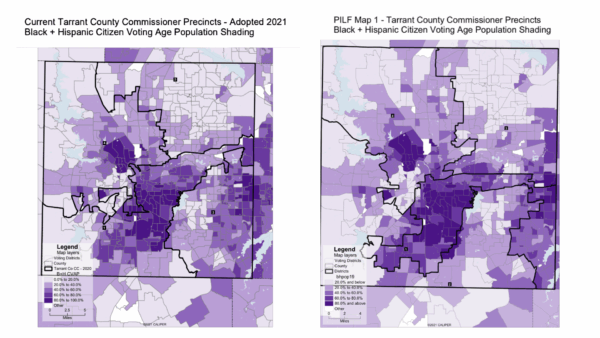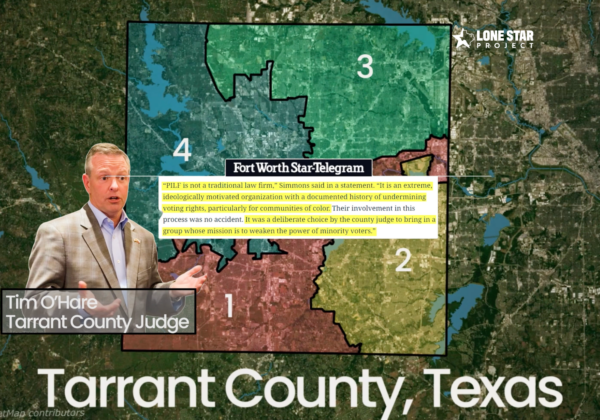Minority residents are most responsible for Texas’ dramatic population growth
- Since 2000, the Texas population has grown by 20.6%. 89% of that growth was from non-Anglos.
- The Hispanic population grew at a phenomenal rate of 41.8%
- The African American population also grew at a very strong rate of 22.1%
- The Anglo population growth rate lagged far behind at 4.2% – lower than the national growth rate of 9.7% and the lowest of all races in Texas.
Good for Democrats, right?
Maybe.
If the Texas Legislature follows the law and protects all existing minority opportunity districts AND respects the new minority population growth in new District lines, then Democrats should be positioned to pick up ground in the Legislature and in Congress.
Texas Population Growth 2000-2010
| 2000 Population | 2010 Population | Increase in Population | % Increase Pop | Share of Increase |
| White | 10,933,313 | 11,397,345 | 464,032 | 4.2% | 10.8% |
| Hispanic or Latino | 6,669,666 | 9,460,921 | 2,791,255 | 41.8% | 65.0% |
| African American | 2,364,255 | 2,886,825 | 522,570 | 22.1% | 12.2% |
| Asian | 554,445 | 948,426 | 393,981 | 71.1% | 9.2% |
| Non White Total | 9,918,507 | 13,748,216 | 3,829,709 | 38.6% | 89.2% |
| Texas Total | 20,851,820 | 25,145,561 | 4,293,741 | 20.6% | 100.0% |
Source: 2010 U.S. Census
Population is growing most rapidly in suburban and exurban areas
The areas of Texas experiencing very fast growth are suburban and exurban parts of North Texas, the Houston Area and the I-35 Corridor
County | Growth Rate |
| Williamson | 69% |
| Fort Bend | 65% |
| Collin | 59% |
| Montgomery | 55% |
| Denton | 53% |
Good for Republicans, right?
Not necessarily.
Suburban and exurban counties are already overrepresented A disproportionate number of the current Texas Congressional, State Senate and State House districts are already controlled by Anglo voters in suburban and rural parts of the State.
Suburban and exurban growth was largely fueled by non-Anglos
Just as important, the new population, even in the suburban and exurban counties, is driven by minority growth.
- In Collin County, north of Dallas, the African American population nearly tripled since 2000 and the Hispanic population more than doubled. In Denton County, the African American and Hispanic populations doubled.
- In the Houston area, including Montgomery, Fort Bend, and Brazoria counties, minority growth was explosive and each county is now at least 25% African American and Hispanic.
- The I-35 Corridor in Central Texas has also experienced huge growth. Williamson County has grown by almost 70% since 2000. Of those 172,000 new residents, 80% are African American, Hispanic or Asian.
What’s Next?
Over the next several days, the Texas Legislative Council will release census data broken down at the precinct level which can then be used by Legislators to model proposed district lines. These data will also become available to advocacy organizations and to others.
Republicans will furiously spin that Texas is a Republican/Conservative State and a disproportionate number of districts should be controlled by Republican voters. They will likely use Tea Party Republican spin-off organizations like the King Street Patriots to play the “bad cop” to push proposals that overtly harm minority voters.
Hispanic organizations like MALDEF and LULAC and African-American organizations like the NAACP will accurately claim that the increased Hispanic and African American populations must be accounted for and respected in new maps. This will mean protecting all current minority opportunity districts and creating new minority opportunity districts where possible.
Unlike some previous redistricting years, Democratic interests this time align very closely with those of minority advocacy groups. The technique used by Republicans to win advantage in redistricting in the past has been to undermine the voting strength of minority voters. That won’t work this time. Efforts to correct past harms done to minority voters will also make the overall maps fairer from a partisan standpoint as well.



